The Manatees of Florida’s Blue Springs
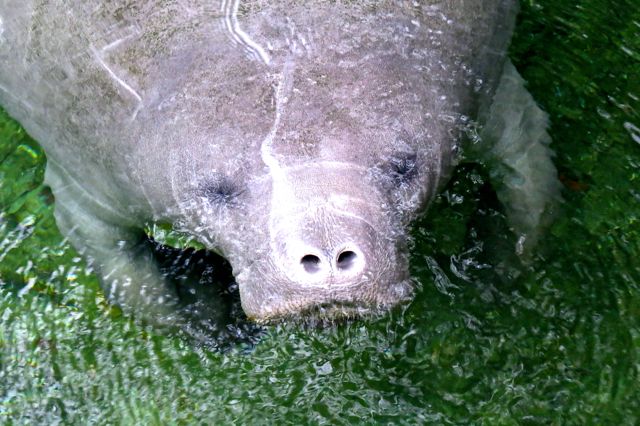 There are few animals as universally popular and liked as much as the Florida Manatee. Yet there are few animals in more danger.
There are few animals as universally popular and liked as much as the Florida Manatee. Yet there are few animals in more danger.
The Florida Manatee, a large and slow moving aquatic animal, is protected by the federal Engangered Species Act of 1973, primarily because they are too big and slow to get out of the way of speedboats. As Florida’s boating population has exploded, the manatee has declined to an estimated statewide population today of under 5,000.
They used to be everywhere. And despite gallant efforts by wildlife managers to protect it, each year there are fewer and fewer.
But if you want to see one, perhaps the best bet in all of Florida is the Blue Springs State Park, in Orange City, FL, less than 45 minutes northwest of Orlando. Here, every winter from November to mid-April, a spit of water called the Blue Springs Run is filled with the gentle giants, often called sea cows. The Blue Springs Run flows into the St. Johns River and emanates from a deep underground spring that burps up crystal clear water that never varies from a temperature of 72 degrees.
That’s what draws the manatees. Blue Spring is a designated Manatee Refuge and the winter home to a growing population of West Indian Manatees. Some years, as many as 350 of them have wintered in the run, which is only about a half mile long and 100 feet or so wide.
For RVers, the state park has 51 large and private campsites, all with picnic tables, a firepit and full electric and water hookups.
Jennifer and I found it a delight of a place. It is quiet and remote – there are signs warning about feeding the bears which are often seen in the park – and while the springs are a half mile walk away, a shaded walking path starts from right next to site 18 and takes you right to the boardwalk that parallels the Blue Spring Run.
Towering old live oaks grow from the banks of the run with Spanish Moss dangling down right to the waters surface.
Although they call it Blue Springs, it has a distinct green shade to it because of the algae in the area caused by agricultural runoff into the St. Johns River.
The water is amazingly clear. Right from the boardwalk, you can see giant largemouth bass, longnose gar, channel catfish and more than 40 other species of fish cruising past.
And then there are the manatees.
On the day we visited, a ranger told us the morning count was 30. As the weather is warming up here in central Florida, the manatees are moving into the river and its tributaries. By the middle of March, they’ll mostly be gone and the river will open to swimmers, snorkelers and SCUBA divers.
We spent several hours strolling the boardwalk and just watching the manatees. They are huge, 800 to 1,000 pounds and ten feet long. Some have grown to nearly 3,000 pounds. We were surprised to learn that they are a relative of the elephant. But when you study them up close, you can really see the resemblance. They are grayish brown in color and have thick, wrinkled skin on which there is often a growth of algae. Their front flippers help them steer, or sometimes crawl, through shallow water. They also have powerful, flat tails that help propel them through the water. Despite their small eyes and lack of outer ears, manatees are thought to see and hear quite well.
Most of them bore deep scars on their backs from boat propellers.
As if that wasn’t enough, the manatees are also being harassed by an invasive species -the sailfin catfish. These are the same exotic species that are used by fish hobbyists to clean the sides of their aquariums. How they ended up in Blue Springs Run isn’t known for sure but someone likely someone dumped them. The species thrive there and they are now all over the place. They fasten themselves to the backs of the manatees and try to eat the algae that grows on them.
This drives the manatees nuts and they twist and roll trying to dislodge the parasitic hitchhikers. That means they burn more calories. Which means they need more food. And since there is nothing in Blue Springs Run they eat, that means they have to roam out into the St Johns River. The St Johns River in the wintertime is much colder than the springs and the prolonged exposure to cold endangers the manatees health.
It’s the classic environmental domino effect.
We sat and watched the manatees for an afternoon and part of the next morning. We could easily see them lying on the bottom of the Blue Springs Run. About every two to four minutes, they’d slowly rise. Just their nose, and only the nostrils at that, would break the surface. You’d hear them exhale, and then inhale, making a deep puffing sound. Then they’d drop down again.
A couple of the manatees had calves with them, bringing smiles to all those watching.
The Blue Springs State Park instantly became one of our favorite Florida memories. In summer, when the manatees are gone in large numbers and the springs turns into a giant swimming hole, it can get quite crowded. Even now, the campground is filled most weekends.
But bookmark this or make a note of it. You’ll thank me once you visit it.




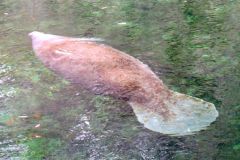
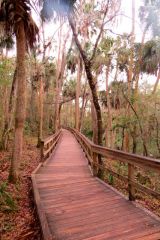
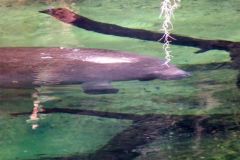

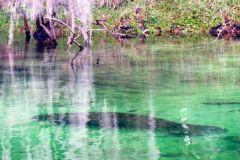

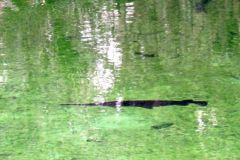
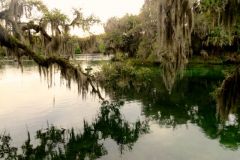
0 Comments
Recommended Comments
There are no comments to display.
Please sign in to comment
You will be able to leave a comment after signing in
Sign In Now